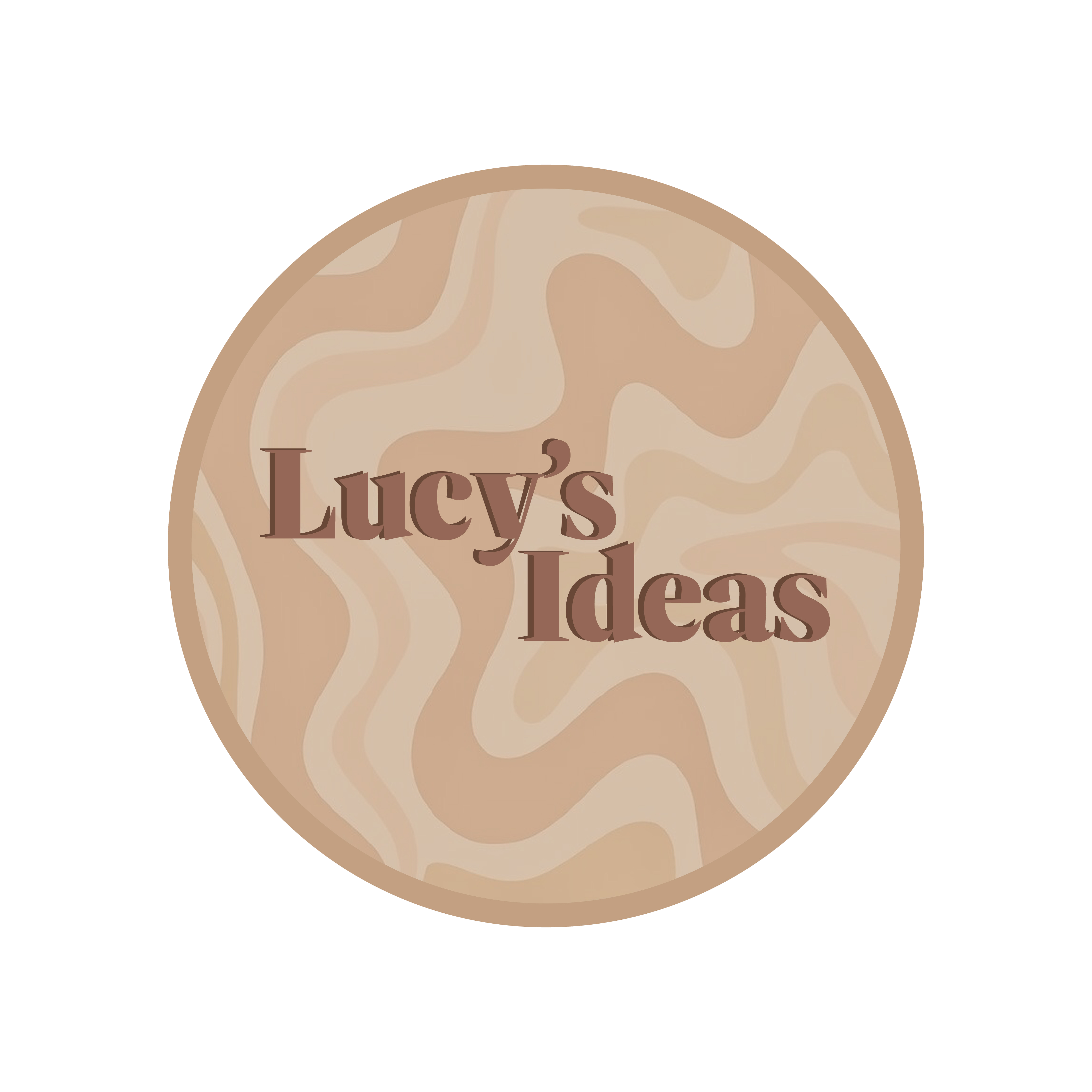Research Overview
“Virtual reality lets users explore simulated experiences in a three-dimensional environment; it’s interactive, so users’ actions can change the scenery around them.” (skillshare.com, 2021). This medium is a great example that allows traditional media (film, books, etc.) to be transformed into digital experiences. I aim to use this technique to produce an organic botanical garden which will allow the audience to escape and explore a scenic, relaxing space. To guide me throughout the planning process, I am using the Cambridge University Botanic Garden as a reference point. Producing this tour of the landscape in VR will allow users to explore the 40 acres of plants without having to leave the house and travel. I will ensure that the project has a realistic layout with an artistic spin by painting the aspects of the gardens.
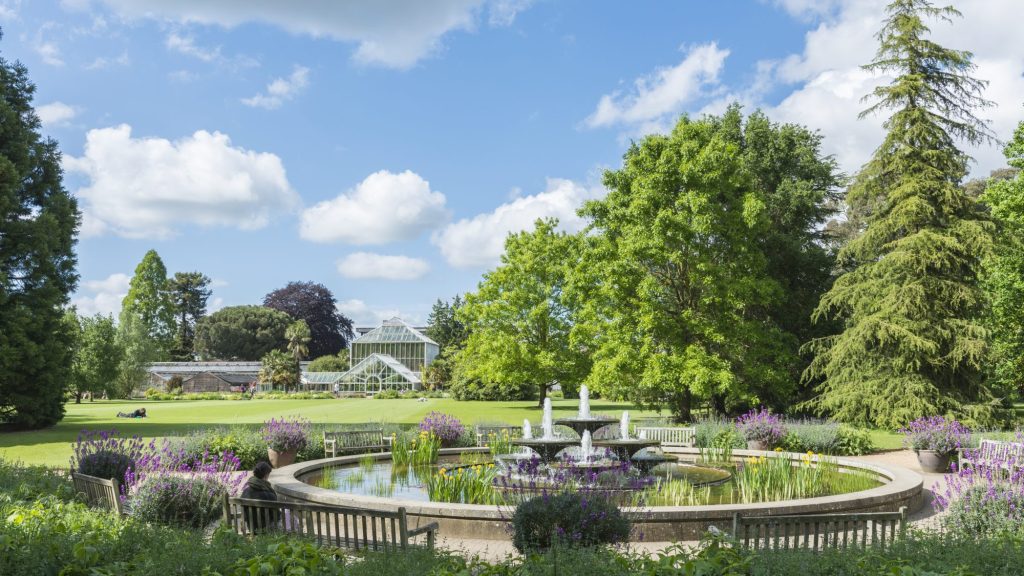
VR art is a very popular medium for artists to use when venturing out into the digital world; so, as you may imagine, the field can become quite competitive for projects that have already been composed. I intend to produce a vague topic that has minimal examples out there already to ensure I can grab the user’s attention and have them want to engage with my project.
I have discovered 2 key pieces that have inspired my idea to create the botanical gardens in virtual reality. The first being a recreation of the New York Botanical Gardens produced in Google Tilt Brush by Tom Christopher and his team. On his website, you can see numerous screen-captures of his progress down to his sketches from the gardens, which foreshadows how I intend my virtual environment to be created. Every plant has been carefully sketched with precision to ensure that the user feels the realistic approach to the New York Garden. Using Tilt Brush has allowed for a first-hand experience when creating the room and for Tom to see what the audience will when producing the scene. This warrants the artist to connect with the user the entirety of the production so that the experience is as seamless/user centred as possible.
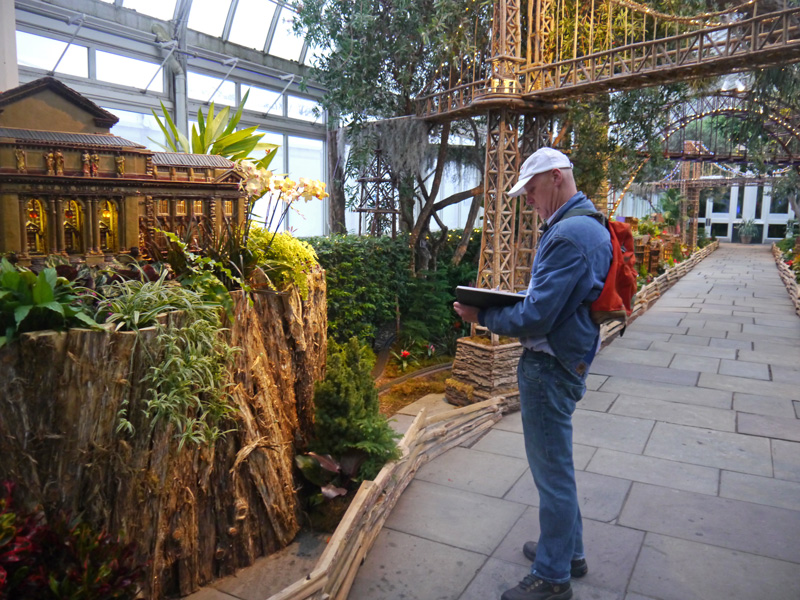
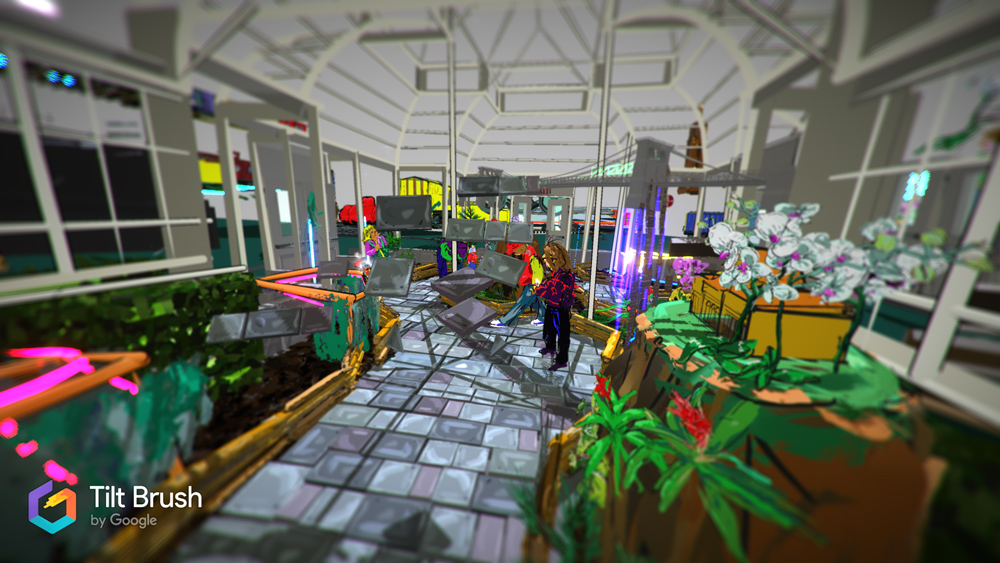

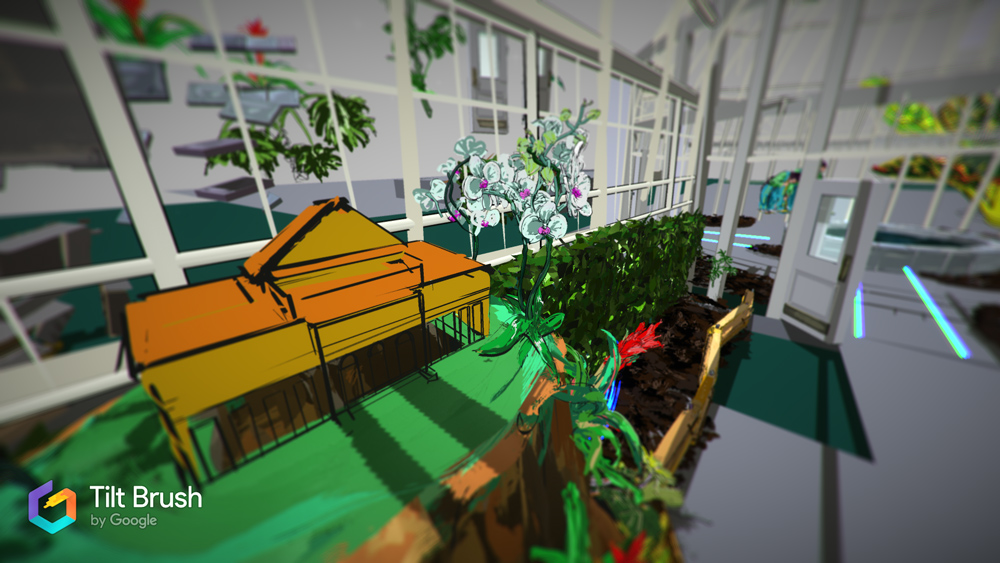
The second example is taken from Cancer Research UK who produced a virtual reality infinite garden at Hampton Court Palace Flower Show called the “Life Garden”. It involves “more than 100,000 flowers featuring names of supporters who left a gift to the charity in their will.” (Gwynn, 2016). Along with the visual component, the sound elements position the user in the three-dimensional space to enhance the emotional connection between the flowers and legacy of the names. The founder of the project, Guy Bradbury quoted, “Virtual reality is too often used as a gimmick – to make people feel like they’re on a roller-coaster or walking through a fantasy world.” (Gwynn, 2016). This has entirely inspired the unconventional garden that I want to create and move away from using virtual reality in an adventurous purpose. In my project, I want to reach the audience on an emotional connection and for them to be able to come to this virtual world for calm and peace.

My idea will follow the concepts of both projects whilst having my own twist and thoughts on the gardens. I will be unable to achieve the lifelike effect that Tom has when he visited the gardens and sketched each of the plants for reference, however I can use images online to help guide the layout. Further, the Life Garden was a very large-scale project produced by a sizeable team to accomplish the emotional connection between the audience. I will be attempting the same, personal effect but on a smaller level and with a less realistic approach. Instead of the user feeling surrounded by people (their names) I want them to feel like they are the only person in the world when discovering the botanical plants in relation to the calming soundtrack.
Throughout my project, I intend to aim my virtual reality experience to students and young adults who are under some sort of academical stress. The gardens will provide an escape from the pressures of studying and can be used to help with young people’s mental health during exam seasons. Due to the affiliation with Cambridge University, it is essential to produce a message to students that there is support no matter the problem they are facing, even if it is just escaping reality for 15 minutes. There is the option to widen the demographic and we can centre the design to allow public to view the gardens as part of a series of famous botanical gardens, however, the scope of the project would have to be larger with a more sufficient timeframe to allow for the creation of multiple scenes. My preferred audience will expect an interaction with areas of the gardens and to be engaged with the content they are exploring to a level that they can interpret. The user will need guidance when entering the gardens as the initial look may become overwhelming and cause panic.
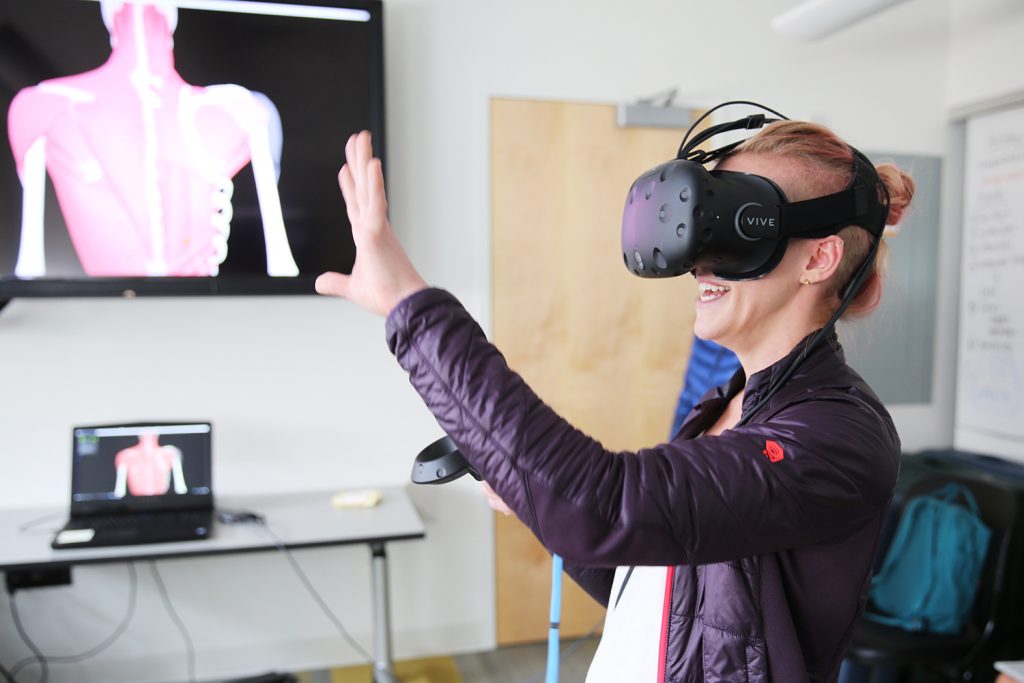
Ideally, due to the small amount of time I must complete this project by, it would be necessary to include pre-made textures and assets that can help my virtual reality art thrive. Obviously, I want to refrain from making the gardens look unrealistic so using certain texture software’s and hinting at a few referenced 3D assets will be key to the approach that finalises the project. Gravity sketch will enable me to create individual assets that I wish to import into my scene such as specific flowers or plants that need refining. The same goes for building large scale objects like my greenhouse; the texture of this will need to be used from a different software to allow for the realistic approach I aim to take. Further, the audio produced will be taken from a royalty-free programme to enhance the user’s immersive, tranquil experience within the virtual world. All assets and textures will be properly referenced in the final part of my production piece.
A narrative is essential when creating a successful VR experience. “Storytelling infuses the virtual worlds we create with depth, emotion, and purpose. A well-crafted narrative provides users with context, and thus guides them through the VR environment with a sense of purpose and direction.” (Fitz-Patrick, 2023). It is important to create a connection between the user and the virtual space to allow them to shape their personal experience and form a bond with the content. When relating my project to narrative, I need to reflect on the tone of the piece and the reasoning behind why they are participating in the experience. The aim is to use quiet narrative and signposting to give the audience a guide around the gardens which focuses on the immersion of the garden and empowers the shape of the unfolding narrative in the user’s hands.
The soundtrack and music further play a crucial role in providing atmosphere and the emotional impact that the user will form with the world. I will produce spatial audio to enhance the audience’s sense of presence within the experience and “incorporate a fitting musical score to complement the story’s mood.” (Fitz-Patrick, 2023). The soundtrack will remain simple but purposeful to ensure the user calms their mind and focuses on the story surrounding them. It will quietly hum in the background while the user ventures into the tranquillised experience. I do not want to rush the audience into exploring and want the initial narrative to remind them to take their time and create an emotional connection with each element they encounter.
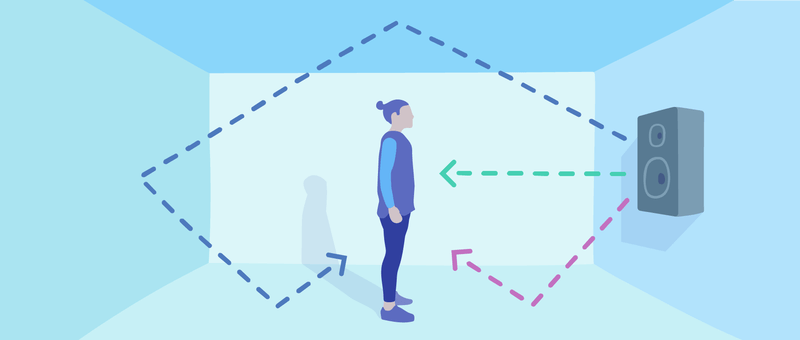
The main form of technology used to create my immersive botanical gardens experience will be virtual reality software and headsets. The specific headset that I will be using for the project is a Quest headset. I will then make sure to get acquainted in the VR environment so that I will be orientated and know what to feel when it comes to producing my virtual reality botanical garden. I want to limit my sessions inside the headset to 20-30 minutes a day for safety reasons and until my body has fully got to terms with the immersive world. My preferred software to create this project in is Open Brush which allows me to paint in the three-dimensional space. I enjoy using the room as my canvas and it gives me creative freedom when designing the scene.
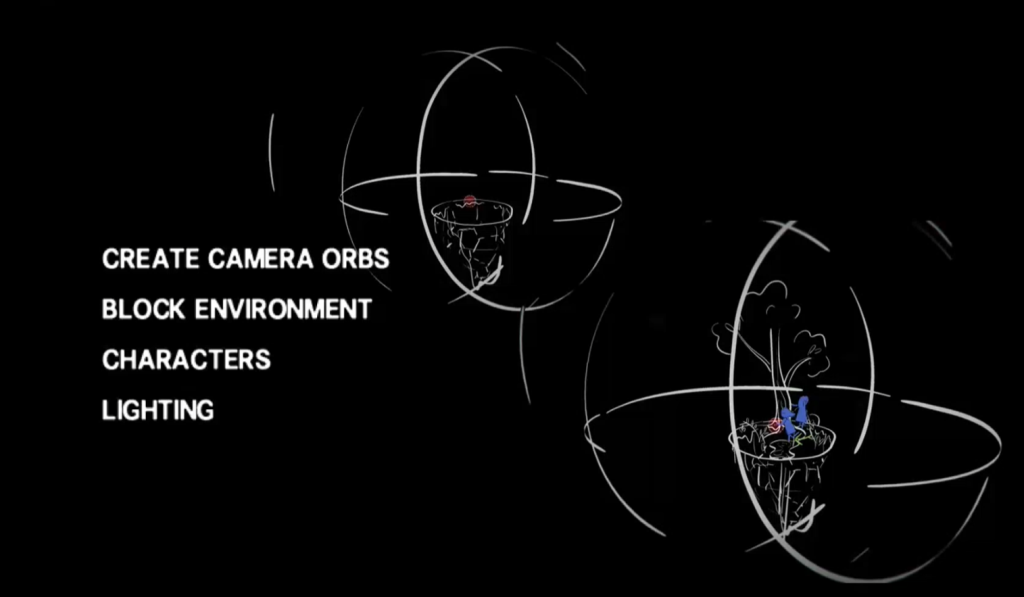
When planning my VR scene, the key strategy that will ensure I create detailed aspects will be using story-sphere’s. This allows some sense to be formed when staring at a blank scene and to ensure I am not overwhelmed by the lack of visuals. I can use story-sphere’s to produce camera’s, block environment, characters, and lighting. Once each individual area is complete and scaled, then I can bring in the surroundings and create a finalised immersive world. I will further refer to sketches and images that I have used from the Cambridge Botanic Gardens to ensure that my scene includes specific features and is familiar to what the user would find when visiting in person. Once the three-dimensional drawing is complete, I can move onto creating spatial audio and adding the calming soundtrack that will play in the background of the user’s experience.
Regular testing of VR content is vital to ensuring a positive user experience and feedback. Prototyping early versions and testing with live demos allows the producer to uncover early issues to do with usability concerns or fine-tuning the content to allow the immersive experience to connect with the audience. In doing so, it is important I follow guidelines and principles that help develop my prototype “according to the standards of my audience and technology.” (Electronics, 2023). Two of the best practices when considering my prototype testing is design for immersion and designing for technology. Designing for immersion ensures that the prototype captivates the users and provides a realistic and consistent sense of interaction. However, designing for accessibility will be focusing and adapting to the needs of the users, confirming their comfort and safety. Both ideas are essential when foreshadowing the final product and the feedback will prioritise the overall user experience for my project.
My prototype will be low-fidelity due to the small time frame that this project expands and the need for feedback within the planning stages. This will mean I can focus on testing the core concepts and interactions with the audience to then gradually increase the fidelity when refining. Throughout the prototyping stage, I will need to incorporate all the criticism and suggestions that are gathered from testing the design. This means “prioritising urgent feedback and make changes to improve the prototype’s quality, functionality, and user satisfaction.” (Electronics, 2023). This testing concept will ensure the numerous amounts of feedback given will help me refine and polish my project. I will follow up with the user’s in a post-test interview to finalise the information and improvement needed to move forward.
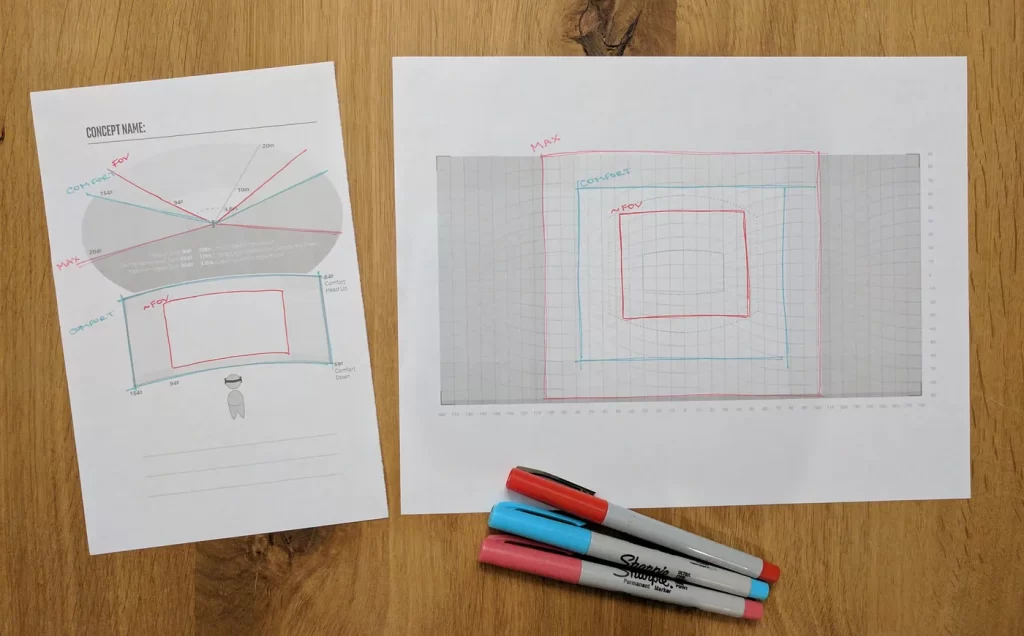
Botanical gardens are seen as very delicate and well-constructed areas for relaxation. I want this to reflect in my contrasting ‘messy’ drawings in virtual reality. Open Brush is an excellent software for creative freedom however, I will struggle trying to keep order and refined drawings in a software that I am completely new to and don’t have the tools to be exact with my references. To keep a visual style that is consistent and supports the theme, I want to keep the drawn aspects realistic so that the audience knows and recognises the world they are entering. When referring to the Cambridge gardens, there is obviously huge amounts of greenery, so I want to introduce bold colours for other plants and flowers so that the user doesn’t get bored or overwhelmed from the continuous colour.
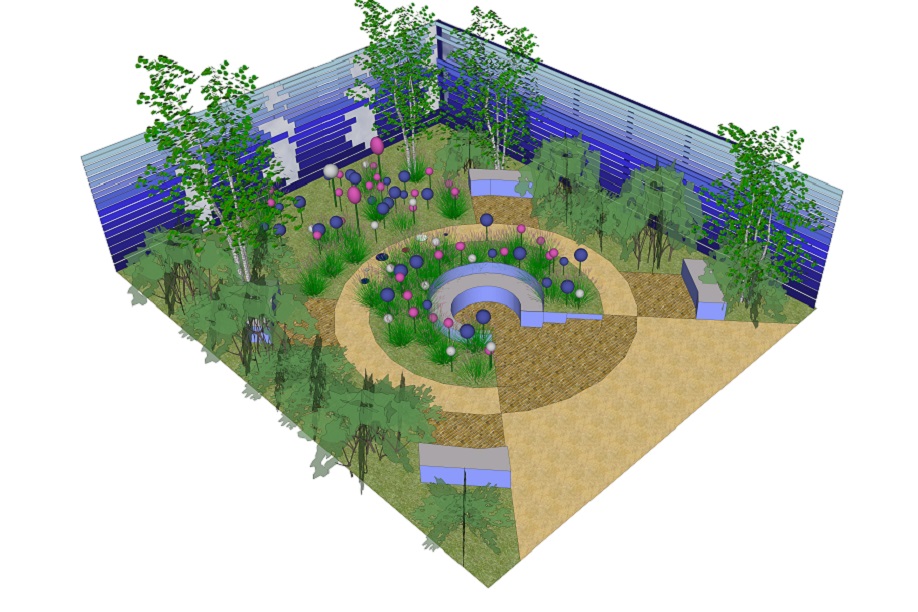
Any typography used on signs or supporting information will follow the tranquillity of the surroundings but will also be clear to follow. The font I have chosen to use throughout the project will be ‘Cassandra’ which provides the delicacy but will also keep the audience steadied when reading information around the scene. This will further help the narrative flow and the user can follow the journey through visual recognition. I will refrain from using bright colour palettes apart from when considering the smaller plants/flowers in the garden. I want the background to be soothing and to keep the realistic approach to the original gardens that I am referencing. I will be making sure to look at the previous examples to guide me through the project.
Ethics are considered “the discipline concerned with what is morally good and bad and morally right and wrong.” (Singer, 2023). When relating this to virtual reality, it is essential that we treat others as we would have them treat us and to reflect this into our simulations created. My specific project will not involve creating virtual persona’s or interacting with other’s in a virtual world so I will not have to think about how ethics will revolve around character development. The only person that will be in the immersive world in the one user who is wearing the headset.
However, I do need to consider VR Guidelines and the physical ethics when thinking of the risks that could harm the user in virtual reality. These risks refer to “motion sickness, information overload, intensification of experience, and cognitive, emotional, or behavioural disturbances after re-entry into the real world.” (Behr, 2005). Obviously, the user being priority to the experience, it is key to ensure that these physical risks are avoided, and the concept remains a soothing escape. As a resolution, I will be testing the interface on numerous participants to solidify the comfortability of the audience and that the content is not intense enough for sickness to arise. I also want to allow steady movement within the content so that when the user disembarks from the virtual world, they will not become disorientated when coming back to reality. The garden will remain a relaxing solution to the user’s hectic educational schedule.
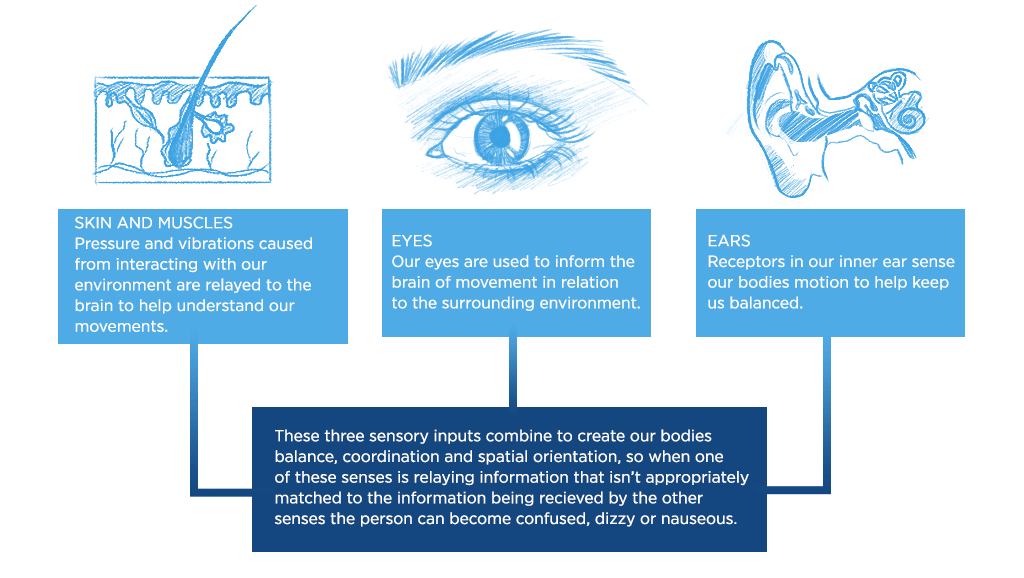
Project Plan
It is essential to have a project plan written and demonstrated before starting any project with complex stages that outlines milestones you intend to achieve over the course. Using a time management tool, I am able to outline the sequence of activities within the project, the anticipated timeframes, and key deliverables at each milestone. I must think rationally when discussing time frames within the small window, for example, I will not have time to progress my project into a series of botanical gardens as this is not feasible. Below you can see I have produced a Gantt Chart in Excel that offers a structured timeline conveying progression of each task which will ensure my project is completely with effective time efficiency.

In Scrum, a user story is “a short narrative that describes a requirement of someone using the software product being built.” (Schiel, 2023). They typically contain a name, a brief narrative, and acceptable criteria for the story to be considered complete. The simple user story template consists of “As a <role>, I want <action>, so that <value or justification>.” User story’s are essential when focusing on how the project will provide value to the audience. Below I have created a user story board which demonstrates the overall goal for our users and individual concerns with solutions. I have found this exercise essential when relating my project to my user and it allows me to step back and think about ethics within the project.
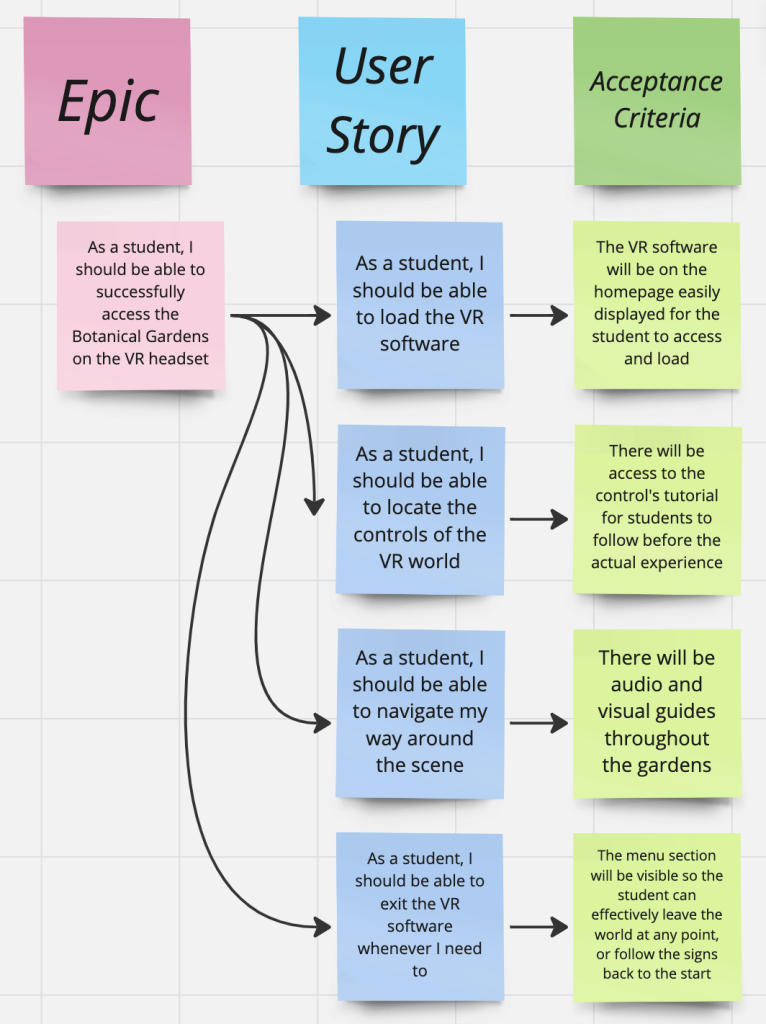
Concept Storyboard
I have created a visual depiction of the user journey throughout my immersive design in a storyboard format that displays the project’s concept and user engagement. “A storyboard is a graphical organiser that consists of images displayed in sequence for the purpose of pre-visualising a motion.” (wikipedia.org, 2023). You can see each stage flows into the next step that the user takes in the project and what interactions take places in the scene. This is an important tool as a graphic designer as it allows effective planning with complex animations. I have included a short description of each key stage and explained how the user is feeling throughout the narrative. The storyboard will be purposeful when creating each stage within the scene and referencing the audience’s journey into the world.
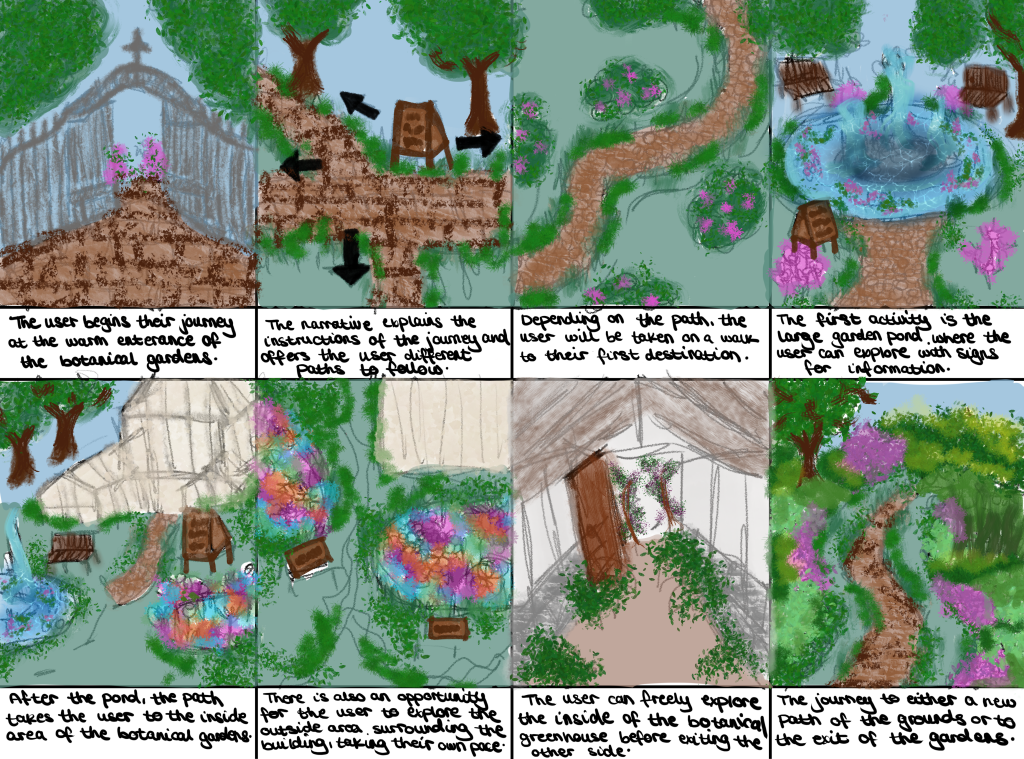
References
Baker, M., 2017. How VR is Revolutionizing the Way Future Doctors are Learning About Our Bodies. [Online]
Available at: https://www.ucsf.edu/news/2017/09/408301/how-vr-revolutionizing-way-future-doctors-are-learning-about-our-bodies
[Accessed 05 November 2023].
Behr, K.-M., 2005. Some Practical Considerations of Ethical Issues in VR Research. Presence, 14(6), pp. 668-676.
botanic.cam.ac.uk, 2023. Welcom to Cambridge University Botanic Garden. [Online]
Available at: https://www.botanic.cam.ac.uk/
[Accessed 05 November 2023].
campaignlive.co.uk, 2016. Cancer Research UK to launch VR garden at Hampton Court Palace Flower Show. [Online]
Available at: https://www.campaignlive.co.uk/article/cancer-research-uk-launch-vr-garden-hampton-court-palace-flower-show/1400866
[Accessed 06 November 2023].
Electronics, C., 2023. How do you prototype for VR, AR, and AI?. [Online]
Available at: https://www.linkedin.com/advice/0/how-do-you-prototype-vr-ar-ai-skills-consumer-electronics
[Accessed 05 November 2023].
Fitz-Patrick, M., 2023. How to Use Narrative as a Design Tool. [Online]
Available at: https://www.interaction-design.org/literature/article/how-to-use-narrative-as-a-design-tool#:~:text=Storytelling%20infuses%20the%20virtual%20worlds%20we%20create%20with,environment%20with%20a%20sense%20of%20purpose%20and%20direction.
[Accessed 05 November 2023].
Gwynn, S., 2016. Cancer Research UK creates VR infinite garden at Hampton Court Palace Flower Show. [Online]
Available at: https://www.campaignlive.com/article/cancer-research-uk-creates-vr-infinite-garden-hampton-court-palace-flower-show/1400789
[Accessed 05 November 2023].
harmony.co.uk, 2023. VR Sickness: What is it and How to Stop It. [Online]
Available at: https://www.harmony.co.uk/vr-motion-sickness/
[Accessed 06 November 2023].
Kamppari-Miller, S., 2017. VR Paper Prototyping. [Online]
Available at: https://blog.prototypr.io/vr-paper-prototyping-9e1cab6a75f3
[Accessed 06 November 2023].
Pryor, A., 2018. Fully Immersive Spatial Audio and Why it Matters in VR. [Online]
Available at: https://vrvisiongroup.com/fully-immersive-spatial-audio-and-why-it-matters-in-vr/
[Accessed 05 November 2023].
rosiesummers.com, n.d. Rosie Summers. [Online]
Available at: https://www.rosiesummers.com/
[Accessed 06 November 2023].
Schiel, J., 2023. The Anatomy of a User Story. [Online]
Available at: https://resources.scrumalliance.org/Article/anatomy-user-story
[Accessed 09 November 2023].
Singer, P., 2023. Ethics. [Online]
Available at: https://www.britannica.com/topic/ethics-philosophy
[Accessed 06 November 2023].
skillshare.com, 2021. Guide to Virtual Reality Art: What It Is and How to Make VR Art Yourself. [Online]
Available at: https://www.skillshare.com/en/blog/guide-to-virtual-reality-art-what-it-is-and-how-to-make-vr-art-yourself/
[Accessed 05 November 2023].
tomchristopher-art.com, 2018. Virtual Reality at the New York Botanical Gardens. [Online]
Available at: https://tomchristopher-art.com/old_site/index.html
[Accessed 05 November 2023].
wikipedia.org, 2023. Storyboard. [Online]
Available at: https://en.wikipedia.org/wiki/Storyboard
[Accessed 09 November 2023].
